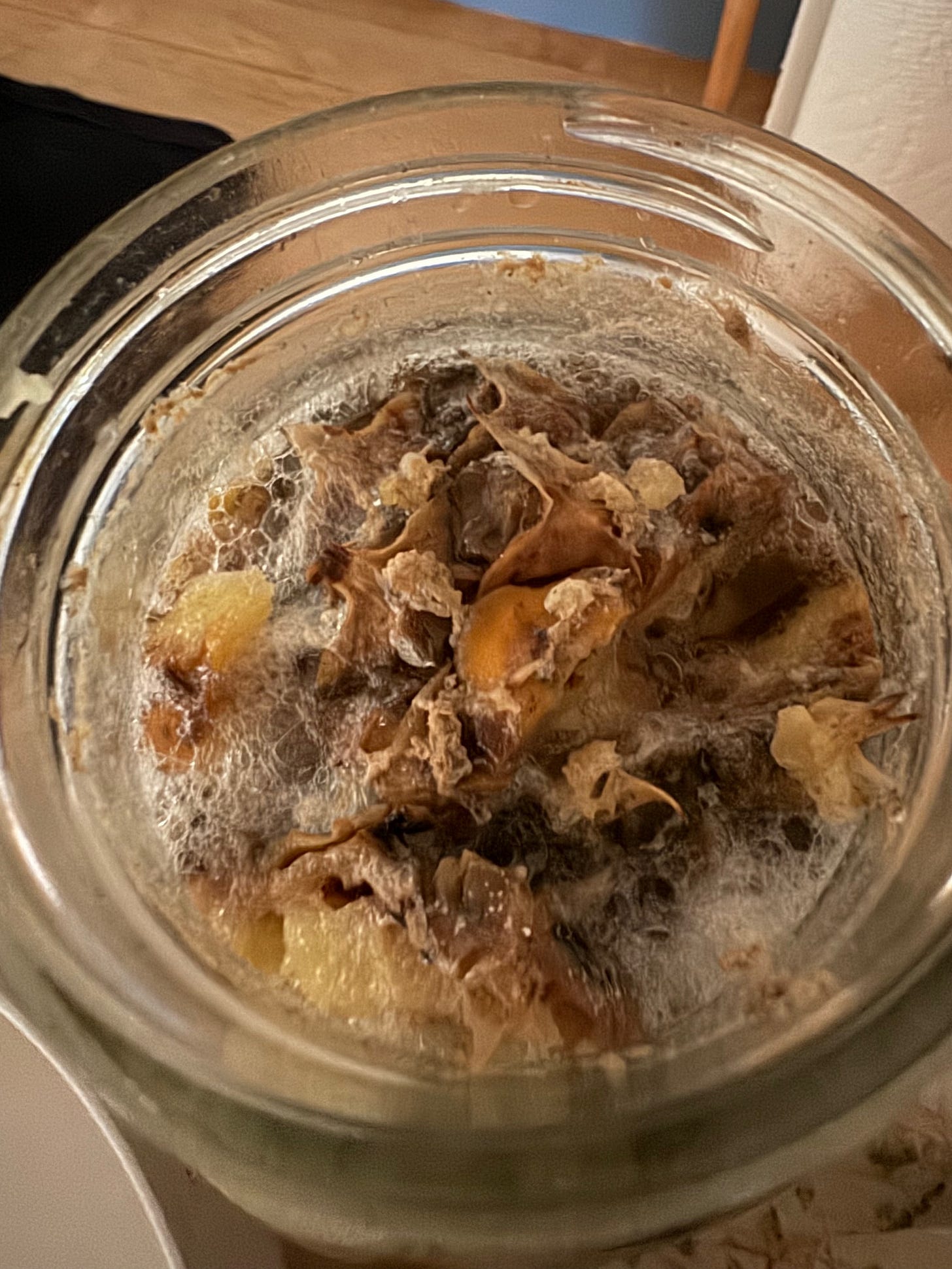Damn! It’s hot!
notes & recipes from a shady kitchen porch: hot peas, a chilled drink, a cold soup
Please just tap on that heart in the upper left corner—it helps me gain credibility. And thanks!
WHEN it’s ninety degrees in the shade on the coast of Maine you know it’s sizzling. And that’s what it is today.
I do not want to sit at the computer to write a Substack post, I do not want to shop the farmer’s market, I do not even want to see how those peas are doing in my garden (suffering, I know). All I want to do is sit on the Kitchen Porch and wait for a breeze to lift the high tops of the old sugar maples and drift down to my level at which point I’ll pour me another sip of a cold, cold drink.
The first summer that I spent in our Tuscan farmhouse many, many years ago, was equally hot. We were not surprised—what would you expect in the Tuscan hills in August? We had no electricity (it arrived later that autumn), hence no refrigeration, hence no ice for that much-desired cold, cold drink. We tortured ourselves with thoughts of ice cubes tinkling, clinking in tall, frosted glasses filled with gin and tonic, and had to be satisfied with small tumblers of sun-warmed white wine. No fridge, no icebox, no ice, what can summer be without it?
Thank the gods, or more likely the goddesses, for modern times and refrigerators. It was a Frigidaire, I’m sure, that had a prominent place in my mother’s kitchen, a great privilege back then when fewer than half of all American homes boasted such extravagance. Nowadays official statistics claim almost 100% saturation--that is, just about every home in the United States has some kind of a refrigerator. It’s hard to believe, but statistics don’t lie, so they say, or not always. Let’s not even mention freezers.
Mrs. Burgess lived across the street from us. She was my earliest BFF. She had no fridge but she had an icebox in her woodshed that was filled each week by the iceman who arrived with big blocks of white ice dripping meltwater from the back of his truck. He would grip one of those dripping blocks in his hefty tongs and then, listing slightly to starboard, lug it up the steps to install in the top of the wooden, zinc-lined icebox. Mrs. Burgess was a sort of auxiliary grandmother and a friend of my own grandmother, a fellow Methodist and member of the WCTU. (“Lips that touch wine shall never touch mine.” I did attend occasional WCTU meetings, but I’ll talk about that another time.) To her dying day my grandmother, born in the late 19th century, never called the Frigidaire anything but the icebox. She had scant appreciation for its ability to turn out regular little cubes of ice to clink in tall glasses.
We did have an icebox up to camp, which had to be filled with ice whenever we went there. If you’ve never heard of it, I must explain that “going up to camp” is an old Maine tradition, getting away from home and living a somewhat more primitive existence for a few summer weeks, preferably at the shore (sea or lake) or in the woods. Think of it as a ritual, a way of being in touch with the ancestors, living as they did at a slower pace. For many years our camp was on Norton’s Pond in Lincolnville. Part of the ritual on the way up to camp was a stop in Youngstown to pick up a big block of ice that had been cut from the pond last winter and stored since, packed in sawdust, in Mr. Young’s barn. Set in the top of the icebox on the shady back porch at camp, it provided chunks of ice for evening cocktails at the same time that it kept the milk and cream, also from Mr. Young’s barn, from spoiling.
A COLD, COLD DRINK
My solution now for a cold, cold drink comes from Chef Jose Andres, that admirable, amiable soul whose organization does so much to feed people in dire straits all over the world, from Ukraine to Gaza to Haiti and on. (If you want to support his efforts, and you should, you can donate to his World Central Kitchen here.)
This, according to Chef Jose, is a Mexican drink called tepache that’s dead simple to make at home. Don’t think you can make it this afternoon and drink it this evening, however. It requires a couple of days to ferment ever so slightly, but once this easy process is understood, you can keep several jars going so you have tepache always at the ready—chilled in your blessed refrigerator and poured over a tall glass filled with clinking ice cubes. Gin is optional as is rum, but most of the time I tend to drink it straight. It’s incredibly refreshing.

Here's how to make it: Take a half gallon canning jar (Ball or Mason or similar) and add to it a half cup of dark brown sugar. Piloncillo, unrefined cane sugar, is used in Mexico but dark brown or demerara will do just as well. Now take a fresh ripe pineapple and cut off and discard the top with its leaves. Cut the fruit in half lengthwise and then cut each half in half again. (This just makes it easier to work with.) Trim the tough central core from each quarter and add it to the jar with the sugar. Now trim all the spiky, prickly skin away from the fruit and add all of that to the jar as well. (The fruit itself, obviously, should be reserved to have for breakfast or dessert or, quite honestly, any time of day you feel you need a bit of a pick-me-up.)
Fill the jar with water (room temp is fine) to a couple of inches below the top and set a folded dish towel over the top, securing it with a rubber band. (Or use a pickle pipe if you have one.) Set the jar aside at room temperature and just let it ferment quietly on your countertop. In about two days, or maybe longer if your kitchen is air-conditioned, it will start to ferment, kicking up a froth on the surface. Let it go for another 24 hours, until it looks like this:
then strain the liquid through a sieve, discarding the froth and solid remains, and refrigerate the juice which will have acquired delicious pineapple-y flavors. Mexicans might add cinnamon or clove to the jar, Chef Andres says, but to me the pineapple itself is so delicious that I don’t want to mask that flavor with anything else.
Tepache will keep in the fridge for several days—I don’t know how long because it gets consumed long before there’s any hint of spoiling.
Thank you, Chef Jose, for bringing this to my attention—forever grateful!
O.C.PEAS
I’m still suffering from an obsessive compulsion with peas, although the season is drawing to a close. Still, I’ve managed to identify two or three places where I can get what I consider the finest kind, now called English peas (back in the day, they were what people meant when they just said “peas, please”), with a flavor that’s far more complex and earthy and interesting than those overly-sweetened sugar snaps. It’s a bit like comparing today’s exaggeratedly candied sweet corn with old-fashioned Golden Bantam. Our addiction to sugar is killing off true flavors.
Enough of that rant!
My latest effort with peas is an old and much-loved Venetian dish called risi e bisi, which means, you probably guessed it, rice and peas. I’ve seen some very complicated recipes from American cooks and I don’t understand where they get information that calls for cooking the rice and the peas separately but in the very same pan—a slippery task at best. Why complicate the simplicity of the dish?
Instead, I turned back to an old friend whom I haven’t seen in years, Sally Spector, an American artist long resident in Venice, who compiled this lovely book, Venice & Food, and wrote--in longhand, my dears--every word herself, plus added the most charming illustrations.
The book is full of history, culture, anecdotes, and tidbits of information—you don’t have to be a cook to love this book for its Venetian lore, and you don’t have to be a Venetophile to love this book for its recipes. And if you happen to be both a cook and a Venetophile, you will love it doubly! And yes, like most books, it’s available on Amazon or you might find it through a reliable dealer in old cookbooks like Rabelais Books or Kitchen Arts & Letters, both great resources for old, historic, and antiquarian food books.
In any case, I was talking about risi e bisi; Sally’s recipe is below the paywall. Scroll down, oh ye paid subscribers, to find it.
COLD SOUP
Another craving in hot weather is for cold soup. Down in Andalucia, the old Arab region stretching across the extreme south of Spain, cooks are experienced in coping with searing summers. There is always a pitcher of gazpacho in the fridge, I was told once by a young cook I met in Jerez de la Frontera, to satisfy anyone who needs its welcome tart and often spicy chill. Jerez, due south from Sevilla, is famous as the birthplace and home town for Spain’s beloved sherry, but it’s also a place where those memories of Arab Spain are kept close to the heart and the cold soup called gazpacho is one of them.
Of course, those ancient Andaluzi Arabs knew nothing of our modern tomato-based gazpacho since the New World fruit did not arrive until some years after the Arabs (along with the Jews) were expelled from Iberia during the Reconquista. It does seem probable that Arab cooks had already perfected gazpacho blanco, white gazpacho, made with sweet almonds and loads of garlic, another summer refreshment that it’s worth knowing about. (I will try to pry a recipe from my daughter the chef, who makes it in her restaurant.)
In any case, this is my recipe for a modern Andalucian gazpacho, as I learned to make it from that chef in Jerez. It comes from The New Mediterranean Diet Cookbook, my tribute to all the healthy, hearty foods of the Mediterranean. For gazpacho, as for any tomato-based dish, a high-quality Spanish picual extra-virgin, if you can find it, makes a happy complement. Personally, I’d look for a picual from Casas de Hualdo, or First Day of Harvest Picual from Castillo de Canena. Both are available from Latienda.com, an online supplier of Spanish food products.
Keep reading with a 7-day free trial
Subscribe to On the Kitchen Porch to keep reading this post and get 7 days of free access to the full post archives.








